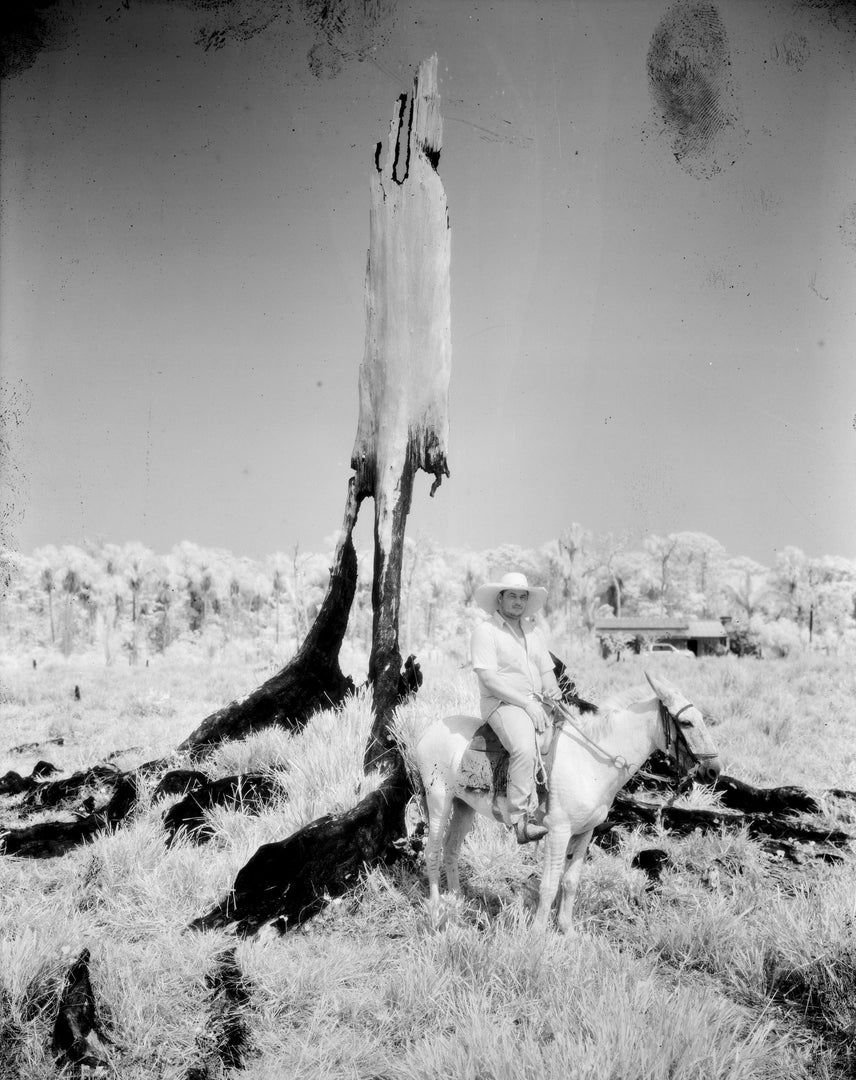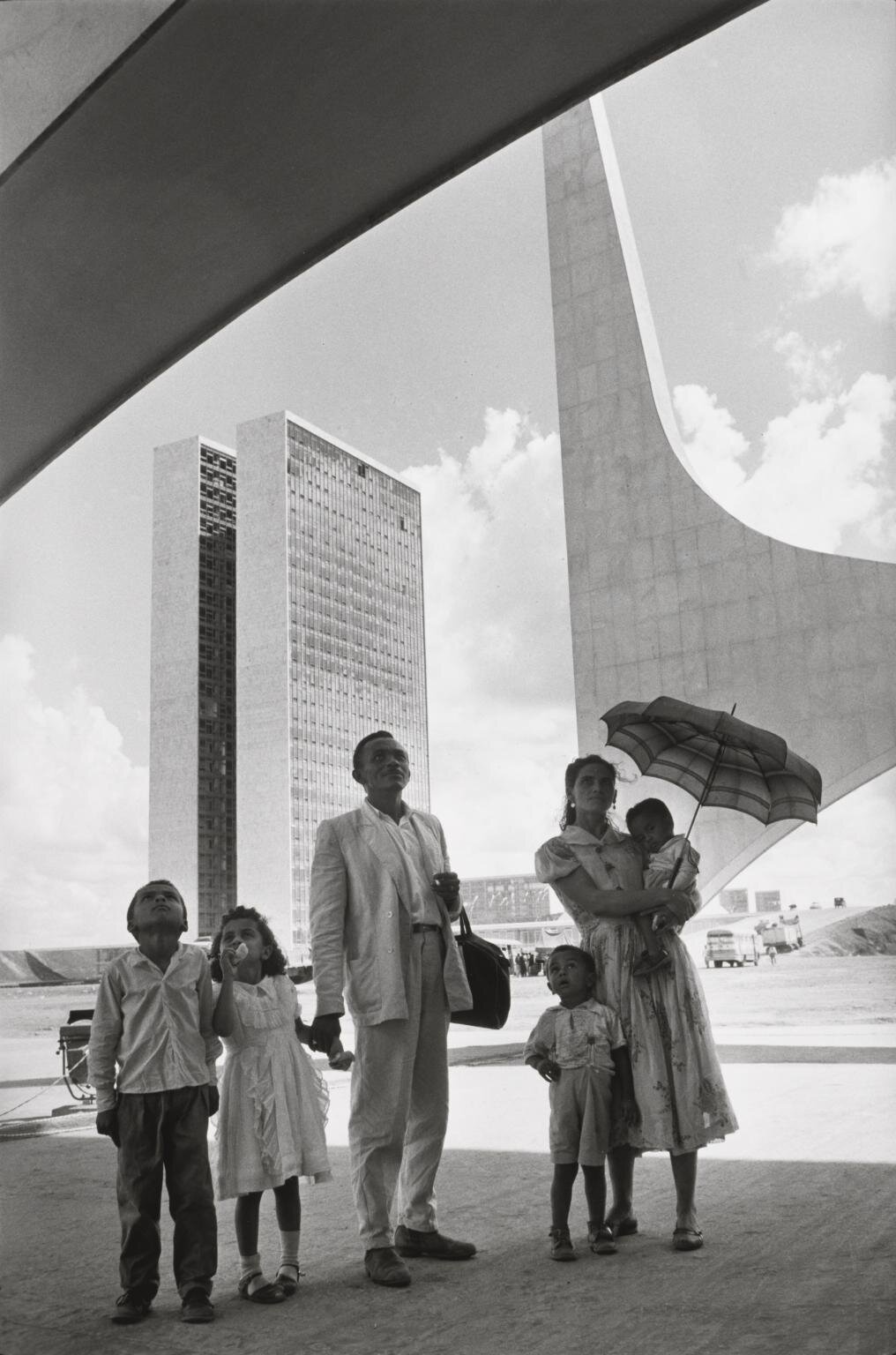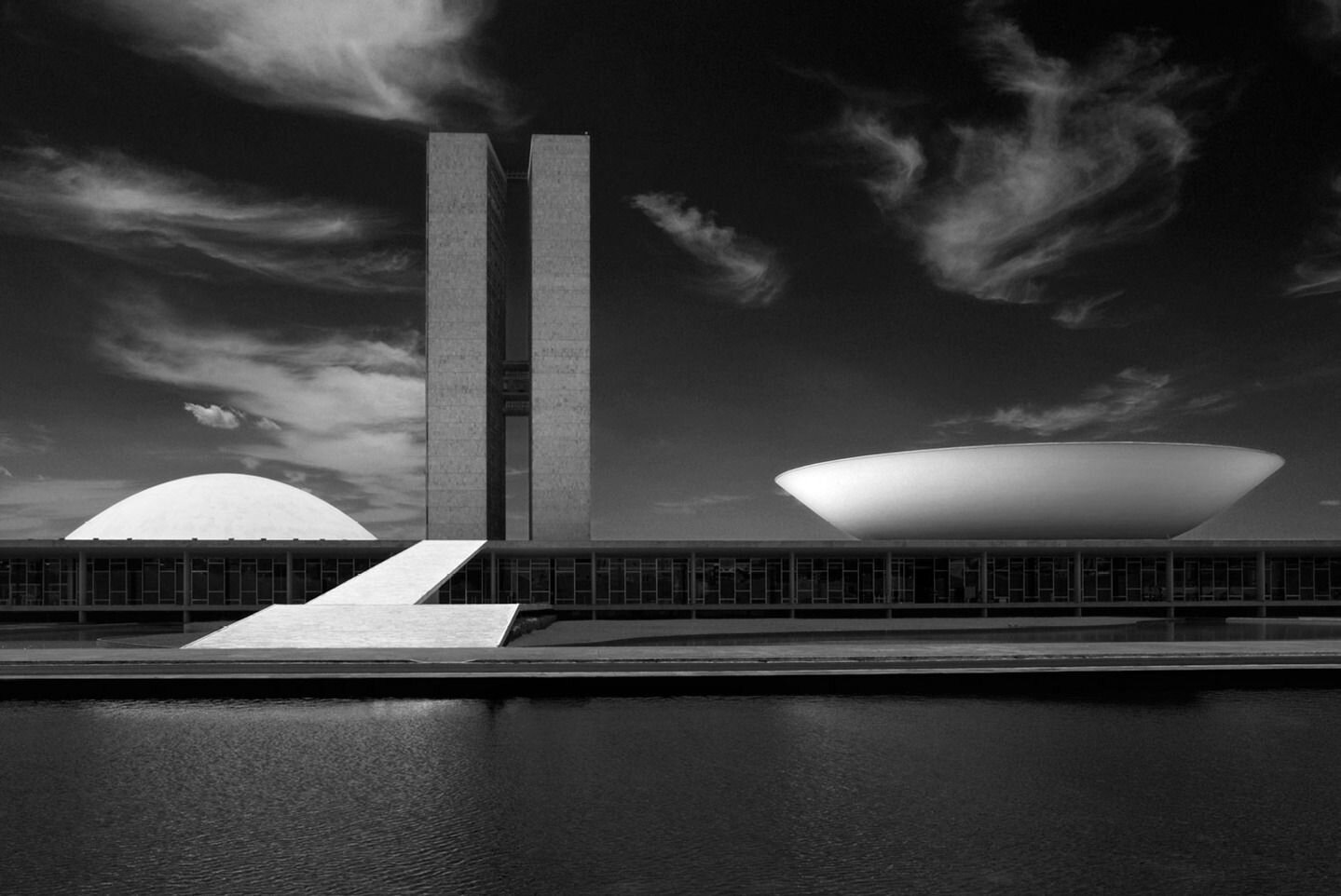‘Broken Spectre’ recalls an eery phenomenon of nature first recorded on Mount Brocken in Germany’s Harz Mountains.
“I would like white people to stop thinking that our forest is dead and placed here without reason. I would like to make them listen to the voice of the xapiri who play here incessantly, dancing on their glittering mirrors. Maybe they will want to defend it with us? I would also like their sons and daughters to understand our words. I would like them to make friendship with our sons and daughters in order not to grow up in ignorance. For if this forest is entirely devastated, no other forest will ever be born.”
There’s a striking tension in the title of Richard Mosse’s new project. The conjunction of two concepts which really shouldn’t go together - one suggesting materiality, the other its opposite: a lingering resemblance of some departed being. Even in strictly metaphorical terms, the image doesn’t feel right, is jarring. We tend to think of ghosts as unitary, indivisible apparitions that may nevertheless contravene the laws of physics. And so the notion that they could somehow break is not intuitive. Spectres may appear, disappear and hang ominously over a place, unseen yet always felt, but they cannot crack like a precious glass vase. As the master-signifier for the cycle of imagery which loops appallingly onwards in Broken Spectre, though, this inherently discordant phrase is, I think, apt. What is the Anthropocene if not a historical epoch, or rather boundary Event, in which we have apparently ‘broken’ the very planet whose Holocene state now figures as a kind of spectre in political discourse?
How this predicament came about is not a question Mosse sets out to answer. Broken Spectre, as multi-channel film and photobook, immerses the viewer in one of the great resource frontiers of the twenty-first century, Amazonia, and confronts us with, as Jon Lee Anderson puts it, a ‘composite view of an almost unfathomable crime in progress’. It’s not just the destruction of primary rainforest with fire and chainsaw, jeopardising all manner of lifeforms. It’s also the reckless daring of the tipping point, beyond which begins the rapid transmutation of the rainforest into savannah, a cascade so terrible it feels unreal. The result is intense, overpowering. You’re never quite sure where to look. There’s no beginning, and no end; just a horrifying, beautiful panorama. And it dramatises something crucial about our situation: very many people continue to act as though ‘nature’ is just that mute, impersonal stuff of Enlightenment philosophy. Basically something to be mastered, acted upon, and, in the fundamentals, dependable - an essentially stable ground for human action.
At certain moments while watching the film, in a sort of pre-reflexive mode of thought, I caught myself wondering: do these people not know that what they’re doing? Do they not care? Much of the film’s power, though, stems from its subtle conveyance of the multi-dimensionality of despoliation. There’s no simplistic moralising, and yet there’s still an implicit meta-narrative - and in this way it confounds. Loggers, ranchers (vaqueiros) and illegal miners (garimpeiros) are not crudely vilified, but on a structural level there is no equivocation or understatement. Ben Frost’s visceral soundtrack, which draws on ultrasonic field recordings - birds, insects and bats - is key to creating this effect. But I had to keep checking myself; even as we’re taken up close to these people, there’s a nagging knowledge that they’re just bit players, local actors - often, too, with few other options. Most of the surplus from these operations is siphoned off to São Paolo or further afield, and in many cases the agents of destruction are languishing in debt bondage. Here then, is the film’s central tension.
In the cultural imagination of the West, at least, the signifier ‘Amazon’ is charged with an existential resonance. The urgency is real. For as we cannot fail to be aware, Earth’s largest rainforest is vulnerable, and we are in danger of losing it altogether. How could somewhere so vast and flourishing just disappear? Although many of her inferences have since lost favour, the archaeologist Betty Meggers’ 1971 characterisation of Amazonia as a ‘counterfeit paradise’ remains helpful. The lush primary forest, she suggested, a remarkable adaptation to unfavourable climatic conditions, is a ‘castle built on sand’. The foundation contributes nothing to the structure’s overall strength, and if the bonds are sufficiently weakened, the entire configuration, this ‘masterpiece of natural selection’ will collapse and disappear.
And yet, at the same time, deforestation has become so normalised, or so Mosse believes, that a radical subversion of the established image regime is needed to shock us into simply seeing it. To this end, much of Broken Spectre is shot on infrared film, specifically Kodak HSI, a discontinued stock which renders vegetation a brilliant, ghostly white. As a result, it’s highly effective in showing up the boundaries between life and death - charred wood and still vibrant, beleaguered striving. In the accompanying photographs, there are almost tender portraits of vaqueiros and garimpeiros, rendered delicate and gossamer-like by the film, which also ‘fails’ in a very visible way, with certain images showing signs of degradation, and others mottled with imperfections and the photographer’s fingerprints. The emulsion is highly sensitive to heat, especially humidity.
The film’s refusal of the conventional documentary style doesn’t end here. Broken Spectre’s searing, psychedelic colour palette comes from a comparatively futuristic technique: multispectral imaging. Unlike infrared, this can capture multiple wavelengths and has wide application in environmental monitoring. Scientists employ the technology to track changes in vegetation cover, detect deforestation and monitor the overall health of the forest ecosystem via satellites. A lofty enforcement tool. But, notably, the same remote sensing capabilities are also employed by agribusiness, to improve yields and precisely manage harvesting times, and by illegal miners to detect subtle variations in soil and topography - the ‘spectral signatures’ which indicate the presence of certain minerals. As such, Mosse’s chosen medium is internal to the narrative; the film could be seen as a kind of immanent critique.
Over the years, numerous artists have sought to represent ‘climate change’, which, in its amorphous yet all-encompassing scope, approaches the unrepresentable. In an effort to visually grasp this ‘hyperobject’, many have turned to the ‘God’s eye’ perspective afforded by aerial photography. Such is the grandeur of the resulting images that, in discussing Edward Burtynsky, Daniel Beltrá and others, commentators often reach for the ‘sublime’ - whether toxic, petro, industrial. All gesturing, I think, to the sense that these blasted landscapes - mines, tar fields, oil spills, landfill site - induce both aesthetic pleasure and existential grief.
Mosse and cinematographer Trevor Tweeten don’t eschew such elevated perspectives in Broken Spectre. Indeed, the helicopter sequences are among the most arresting moments in the film: we fly over clear-cuts, flooded valleys and vast open pits. But it works on other levels too. Blended into the macro, and occasionally interrupting it entirely, is imagery from the other extreme: close-ups of the undergrowth, transplanted chunks of rainforest drenched in ultra-violet light (in another echo of scientific practice) and photographed in a contrived indoor environment. A single square-inch of soil in the Amazon, Mosse reminds us, is ‘tripping with life’, and this dimension of the project reveals the micro-worlds whose interests we rarely consider. These images, ‘almost gothic nocturnes’, also probe the limits of human perception and help to relativise it. In this respect, I was reminded of the concept of Umwelt as proposed by the biologist Jakob von Uexüll (1864-1944) to describe how the world is sensorially perceived by particular organisms. Each inhabits a different subjective environment, and so there is an interpretive gap between human perception and ‘reality’. What we see in everyday life, around 0.0035 percent of the spectrum, is just the quirk of a bipedal mammal. On one level, Broken Spectre could be seen as a meditation on this gap.
Between these two extremes is the human scale, which has two poles: destroyers and defenders. We witness innumerable acts of violence in Broken Spectre: the felling of an ancient tree, hacking and burning, the dismemberment of slaughtered cows. A kaleidoscope so intense I was almost grateful when the panorama shifted back to an overview. The let-up is only ever fleeting, though. In one sequence, the horror returns sonically: an eerie, pulsating cacophony gradually builds until suddenly pierced by a truly spine-chilling siren. There are scenes of daily life on ranches, and of settlers at work. Mosse has spoken of spending the great majority of his time in the field negotiating access to these spaces. The Amazon is among the most dangerous places in the world for environmental activists, so being upfront about his intentions was out of the question. It turned out that flattery was the best approach. These macho figures are often proud of what they’ve achieved, and showing admiration for their tenacity and success in beating back the frontier of the jungle was the best way to win them over. An unpalatable bargain, perhaps, but I think a price worth paying.
Even though they’d doubtless feel betrayed upon watching Broken Spectre, I also wonder whether on some level they wouldn’t mind the portrayal. The vaqueiros in particular are amply dignified. In one scene, the camera follows as they gallop along a track in in ten-gallon hats, the lush vegetation on both sides gradually giving way to a blasted prairie. Evocation of the Western was a deliberate strategy on the filmmakers’ part, an attempt to somehow implicate the viewer through familiar imagery - to remind us that these processes are tied to a much longer history of encroachment into ‘wilderness’ by Europeans. Remarkably, only around one percent of the Amazon’s primary forest was lost before 1970. But with the construction of the Trans-Amazonian Highway under the Brazilian military dictatorship (1964-1985), and, not long after, BR-163, the ‘Soy Highway’, the rainforest was opened up for large-scale exploitation. In this way, it is just the latest bitter frontier of ‘progress’.
If industrial plundering of the rainforest is a relatively recent phenomenon, the decimation of its native peoples is not. Until quite recently, it was thought by scholars that pre-contact communities were small and itinerant. But it is now widely believed that the seasonally-inundated várzea floodplains, at least, were densely populated before the arrival of Europeans. Evidence points to the presence of agricultural chiefdoms in areas like Marajó island, and it’s even possible that, in addition to cultivating maize and manioc, people managed banana plantations. Crucially, though, none of this activity undermined the ecosystem. In the early 1990s, the archaeologist Anna C. Roosevelt concluded that contemporary Amazonian groups are descendants of people who fled to the unproductive upland environment to escape disease, missionaries, and slave raiders. Recognising this history not only underscores the devastating impact of the conquest, but also stands as a corrective to longstanding portrayals of the rainforest as essentially primeval, untouched. Even after overtly ideological narratives about ‘savages’ lost traction, certain strains of anthropology continued to propagate a geographically deterministic view of indigenous Amazonia up until the 1980s. According to the paradigm of cultural ecology, in particular, the attainment of civilisational autonomy was prohibited by native peoples’ subjection to a hostile, constraining nature. Roosevelt’s approach was instrumental in sidelining the view that Amazonia lacked the necessary conditions for social complexity to emerge.
Another perspective can be gleaned from ethnography. While developmentalist discourse relies on the Amazon being characterised as a wilderness, for the Achuar of Ecuador, as the anthropologist Philippe Descola has observed, the rainforest is rather an immense garden carefully cultivated by some spirit, an ‘extension of the world of the homestead’. Not only does it provide an abundance of food, medicine and hallucinogens, its other inhabitants are not seen as beasts: even the great predators - jaguars, anacondas - are associates of shamans, who are, of course, included in society. As such, the discontinuity of outward forms belies an essential continuity of souls. And although the precise hierarchies and modes of interaction vary across cultures, the ontological system underlying this according to Descola, animism, is common to many Indigenous peoples of Amazonia.
We come closest to an encounter with ‘radical alterity’ in Broken Spectre during the speech of Adneia, a young Yanomami woman. For around seven minutes, the dyssynchronous channels resolve into one (momentarily blacking-out entirely while the reel is changed), as she stands before a circle of her people, flinging her arms with every utterance, at once distraught and furious.
‘Who will helps us to live in peace? Who will recover this forest?…It’s no use saying for nothing that you have lots of money. Put up a wire forbidding the prospectors to pass! Help us! Bring health back to this place! We want to live in peace. Be firm! You white people, see our reality! Open your minds! Don’t let us talk so gallantly and do nothing…This is what I ask of you, my friends: don’t film me for nothing. I don’t want that. I want you to really help me.’
It makes for deeply uncomfortable viewing. Sitting there in a darkened basement off one of London’s grandest streets, aware that our daily actions interpenetrate with the processes driving destruction of the Yanomami world, we know, feel, that we are the probem. But perhaps what’s most unsettling about the soliloquy is the nagging feeling that it won’t make much of a difference. With the return of Lula to office, there is hope, once again, that deforestation can be slowed. But it will take time to restore environmental agencies gutted under Bolsonaro, and it’s possible that 2023 will even see a rise. At the start of the government’s operations against garimpeiros in January, officials estimated there were up to 20,000 people connected with illegal mining in Yanomami territory - a chilling indication of the previous administration’s negligence. In a country riven by culture-war, in short, the long-term forces arrayed against the rainforest are formidable.
The Yanomami have long been one of the best-known Indigenous peoples among anthropologists and Western publics - if not for wholly salubrious reasons. In recent years, though, their mythocosmology has travelled beyond ethnographic circles in a more or less unadulterated way via a remarkable book, The Falling Sky: Words of a Yanomami Shaman (2013), which, like Broken Spectre, contains a profound appeal to the Western conscience. In some ways a kind of memoir, offering an account of Davi Kopenawa’s upbringing, his shamanic induction (‘becoming other’) and subsequent expeditions into the world of whites (the people Bruno Latour calls ‘Moderns’), first to Boa Vista and Manaus, and then to far-flung cities in Europe and North America, it also provides an unparalleled insight into the Yanomami thought-world. Part two of the book, ‘Metal smoke’, offers a haunting account of how Kopenawa makes sense of the death and destruction wrought by settlers - ‘Earth-eaters’ - in Yanomami cosmological terms. Although we don’t know to what degree his beliefs differ from other Yanomami, The Falling Sky can therefore be seen as a kind of direct, hermeneutic counterpart to Broken Spectre.
In conversations with the anthropologist Bruce Albert, Kopenawa vividly describes his confrontations with garimpeiros. He is forced to watch as they dig vast ditches, blast the land with high-pressure jets and soil the waterways with motor oils and a yellowish mud, all in a quest for an ‘evil thing’ about which the Yanomami knew nothing - gold (a vain search, anyway, because such dust is only derivative of the ‘true’ metal, which, Kopenawa explains, is buried much deeper and defended by spirits). Sometimes, working alongside FUNAI agents (the federal agency responsible for protecting Indigenous territory), he was able to expel prospectors from his ancestral land. But they always came back, in greater numbers, armed and ‘very bellicose’. Now, perceiving the desynchronisation of seasons and hydrological cycles, the shaman senses that the world is heading towards chaos. Fumes from factories are spreading in all directions, sickening trees and endangering even the xapiri spirits. The sky itself will become riddled with holes from the heat of mineral fumes, an outcome so far avoided only because hutukarari sky spirits are constantly pouring water on it to cool it down. But they cannot defend the Yanomami against evil things indefinitely.
As the Yanomami see it, the ignorance of whites (nicknamed ‘monster peccaries’ on account of their ceaseless digging and upsetting of the soil) as to the agency of spirits and shamans has already started unleashing a supernatural revenge in the form of droughts and deluges. If ecological unravelling continues, the last shaman will die, evil spirits will take over the cosmos and the sky’s roots will be torn out. Kopenawa is tormented by all this, and has sought for years to make whites understand. Perhaps if their thought could be steered away from minerals and merchandise, they might be able to ‘dream of something other than themselves’. Several times in the book, he expresses hope that young people may hear his words and show ‘far more friendship for the forest’ than their forebears. Although delivered more directly, this is also Adneia’s plea.
Davi Kopenawa with Yanomami children, Watoriki community. Fiona Watson, 1991 .
Before visiting the exhibition, my main qualm was that Broken Spectre would aestheticise ruination. Mosse has been criticised for this in the past, fairly or not. But when it came to it, the experience was so unsettling, the documentation so brute and unsparing, that my concerns were mostly dispelled: there’s a way, I think, in which the inherent tension between beauty and devastation is productive. In previous attempts to represent the climate crisis, environmental destruction has often figured as a thing rather than a contingent process - and not just as a function of the medium’s intrinsic fixedness. The epic composites of Burtynsky, for example, arguably show the impact of human ‘progress’ on such an abstracted scale that they effectively negate hope that something could be done to arrest our death-march. Disconnected from the social and political context, moreover, they invite us to adopt a purely contemplative stance, to gaze upon despoliation in a way that arguably promotes passivity. In this way, as Clint Burnham has suggested, they allow us, perversely, to ‘enjoy our symptom’.
For me, Broken Spectre’s multi-perspectival structure, as well as Adneia’s speech, an unforgettable inflection point, are the keys to a more complex, unsettling work of art. The project is an indexical record of unfolding physical, chemical and biological processes, but it also raises questions about the transparency of images and the ways in which we are culturally attuned to respond to them. We can’t really believe that the Amazon is being sacrificed for the sake of cattle and soy, that the panoramic horror unfolding before us is all for profit. At the same time, though, we recognise our complicity in the integrated global system that drives it, and the film’s power derives in part from this sense of dislocation. Mosse doesn’t downplay the criminality of the settler-invaders, but he does remind us that short-termism, binds and self-justifying behaviour are not localised in climate flashpoints; they are an almost universal condition of humanity in the Anthropocene.
Reflecting on it afterwards, it struck me that, in its appropriation of sophisticated scientific imaging techniques, Broken Spectre is inextricably tied to the very complex of forces that have taken us beyond the point of no return. Despite its decidedly anti-naturalist aesthetic, the film could be seen as an advanced product of naturalism, the ontology of the Moderns according to Descola. Only under the hegemony of naturalism, whose foundation is a mute, impersonal Nature, could the Earth be plundered with such wanton disregard. In contrast, the Yanomami - and countless other Indigenous peoples - take for granted that humans are just one element in a vast whole in which no real discrimination is made between themselves and non-humans. Nature, in other words, is subjectivised.
Does this matter? I don’t mean it as a criticism of the film per se, which may be the most powerful work of art yet made about climate breakdown. After all, one could make this argument about photography itself, a medium long harnessed for conquest and resource extraction. Merely to suggest that it is inescapably external to, and disconnected from, the Umwelten of the humans and non-humans it sets out to champion. This gap is thrown into sharp relief by The Falling Sky, which offers a glimpse of what it might be like to live in a world charged with agency. Ultimately, both works aim, on some level, at cross-cultural communication. But while the film presents only absence (of health, autonomy, a secure future ), the book gives us - in immense detail - the positive, constructive and affirmative side to the Yanomami. While in the film they are presented as basically reactive (though certainly not passive), the book gives us a rich and textured insight into an alternative way of simply being in the world.
Collective house near the Catholic mission on the Catrimani River, Roraima. Claudia Andujar, 1976.
Although Davi Kopenawa long ago renounced his youthful wish to become a white man, he continues, in his late sixties, to engage in outreach and activism. Just this year, he attended the opening of ‘The Yanomami Struggle’ in New York City, an exhibition of photographs by another friend and collaborator, Claudia Andujar, who first visited their lands in 1971. Strikingly, alongside a number of visionary portraits, the series also includes aerial images made on (colour) infrared film. Although her focus, at this time, was less on highlighting jeopardy than on conveying radical alterity, there is, then, a direct line from Andujar to Broken Spectre.
It may be coincidental that these two exhibitions ran simultaneously on opposite sides of the Atlantic. But it will surely mean that their message was amplified. While the prognosis for the Amazon may seem bleak and the problems intractable, it is equally true that the work of Mosse and Andujar is likely to have unknown and untraceable consequences, rippling out through actions and conversations in a way that makes a collective difference. During sleep, Kopenawa says, the xapiri ‘never stop looking at us and wanting to talk to us...They call us: ‘Father, do you hear us? Or are your ears really blocked?’ At this grave moment in human history, Broken Spectre avers, the responsibility is on us to unblock our ears, if not for the xapiri, then at least for Adneia and the shaman.



















